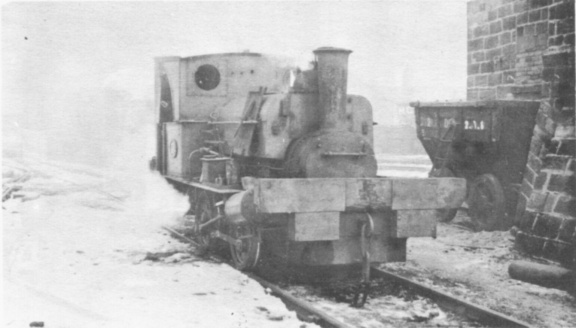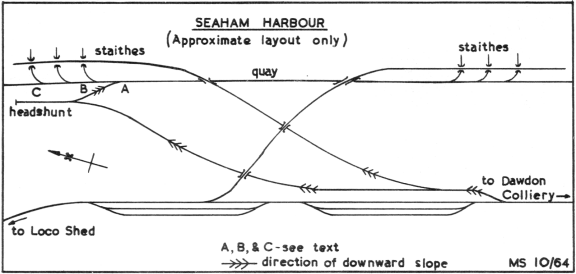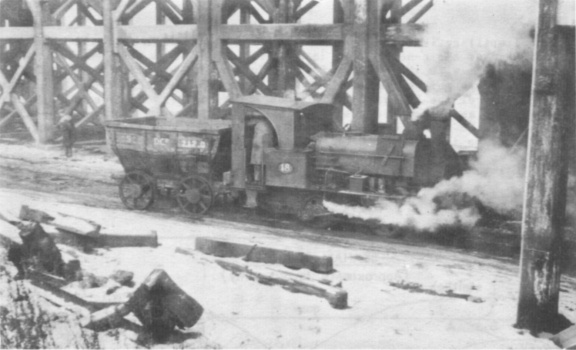
| THE INDUSTRIAL RAILWAY RECORD |
© DECEMBER 1964 |
CHRISTMAS
AT SEAHAM HARBOUR
by R. A. HODGE
(PHOTOGRAPHS BY THE AUTHOR)
In the bleak chill of an English winter I made a pilgrimage on 23 December 1963 to the shrine of the oldest working truly industrial locomotive in the country. As I walked over the frozen snow from the station to Seaham Harbour I could see No. 18 sizzling outside the shed. Built by Stephen Lewin of Poole in 1863 it was in fact the only really old loco on the premises, several old favourites having been reduced to scrap during the year. Various Hawthorns were at work but as many again were dumped, and the second batch of four locos obtained from Dorman Long‘s Acklam Works at Middlesbrough looked to be in a rather rough condition.
It was about dinnertime when I arrived and there was not a lot doing, but before long the Lewin moved off shed and trundled slowly past. After shunting a primitive wagon and its contents of two dustbins from one siding to another, a complicated operation taking some fifteen minutes, it sidled quietly down the inclines towards the quay. I followed by means of a fifty-foot long rickety flight of steps and watched the Lewin run along the quay towards the staithes.

Coal spillage is collected from beneath the staithes in old chauldron wagons, and as the concrete quay is not particularly safe only small locos are allowed on it; with the demise of DICK (Hunslet 628 of 1895) earlier in the month the Lewin reigned supreme. To get a wagon of spillage from the quay to the upper level the Lewin first descends light engine. It does not go under the staithes as the curves are too tight and this means that each spillage wagon has to be pushed out manually. The Lewin then hooks on and the wagon is transferred to the headshunt for collection by one of the larger locos which takes it up the steepest incline to the upper level, Two or three wagons go up at a time and the Lewin banks if necessary.

The events of the afternoon I was ‘there were quite amusing for, although the steep incline had been cleared during the morning, everything on the quay was frozen solid. When I got down there about half-a-dozen men were using braziers and picks to free point A (see diagram) before starting on the track through to points B and C where two chauldron wagons were trapped. The rails being flush with the roadway made for some difficulty in removing the ice. Picks were wielded to loosen a few feet and the Lewin then performed a slow charge, ploughing along until either it skidded to a grinding halt or threatened to become derailed. The retreat was performed with great difficulty, much slipping and some quite precarious swaying. All this continued until the Lewin was within about ten feet of the chauldron wagon at point B. The two were then chained together and after much wheezing and slipping by the Lewin the wagon was freed amid some mad cheering from the, spectators.

The combination of ancient loco and equally ancient rolling stock presented a fine vintage spectacle, and but for the up-to-date attire of the crew and the absence of sailing ships in the harbour I might have thought myself miraculously transported back in time at least fifty years. I had missed one train by watching the freeing of the wagon and, as I waited at the station for the next "green thing", 183 (RSH 7347 of 1947) exploded violently up the bank pushing fifteen 21−tonners from the staithes to New Seaham Colliery. (Isn‘t this bank normally cable-worked? All the cables were in position.)
So ended a day of contrasting impressions - joy at seeing the Lewin at work, but sadness in that so many of the old-timers had passed on, That they had been replaced by other steam locos in these diesel days, however, was adequate compensation.